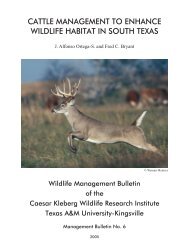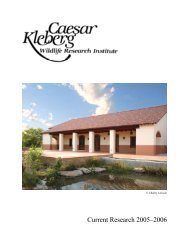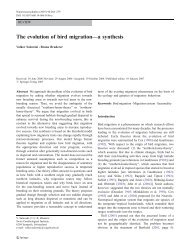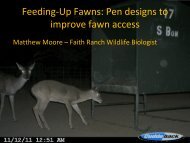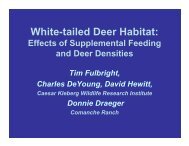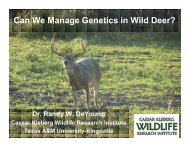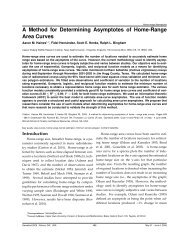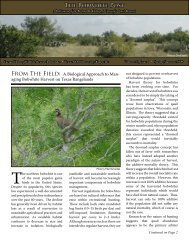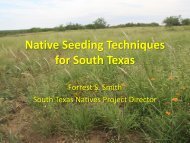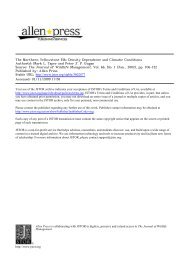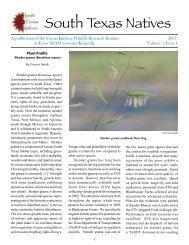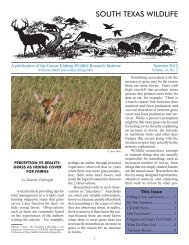nutrition and physiology of white-tailed deer consuming whole ...
nutrition and physiology of white-tailed deer consuming whole ...
nutrition and physiology of white-tailed deer consuming whole ...
You also want an ePaper? Increase the reach of your titles
YUMPU automatically turns print PDFs into web optimized ePapers that Google loves.
NUTRITION AND PHYSIOLOGY OF<br />
WHITE-TAILED DEER CONSUMING<br />
WHOLE COTTONSEED.<br />
S. L. BULLOCK ¹, D. G. HEWITT ¹, R. STANKO ², K. C.<br />
McCUISTION ², M. K. DOWD ³, D. DRAEGER 4, <strong>and</strong><br />
J. RUTLEDGE 5<br />
1 Caesar Kleberg Wildlife Research Institute. Texas A&M University-Kingsville,<br />
Kingsville, TX USA.<br />
2 Department <strong>of</strong> Animal <strong>and</strong> Wildlife Sciences, Texas A&M University-Kingsville,<br />
Kingsville, TX USA.<br />
3 Southern Regional Research Center, ARS-USDA, New Orleans, LA, 70124, USA .<br />
4 Comanche Ranch, Carrizo Springs, TX, 78834, USA.<br />
5 Texas Parks <strong>and</strong> Wildlife Department, Carrizo Springs, TX, 78834, USA
Introduction: Whole Cottonseed<br />
(WCS) as a Supplement (Pros)<br />
~Fed For Over 100 Years~<br />
‣ Increased Interest<br />
‣ High Quality Feed<br />
‣ Protein, Fat, Fiber<br />
‣ Not Readily Consumed by<br />
Non-target Species<br />
‣ Weather Resistant<br />
‣ Inexpensive Set-Up<br />
Photo by R<strong>and</strong>y DeYoung
Introduction: Whole Cottonseed<br />
as a Supplement (Cons)<br />
‣ Gossypol!<br />
‣ Problems in ruminants:<br />
‣ Blood Fragility<br />
‣ Reproduction in ♂s<br />
‣ Antlers<br />
‣ Body Condition<br />
‣ Lack <strong>of</strong> Knowledge
Introduction: Fallow Deer<br />
(Dama dama)<br />
‣ 12 <strong>deer</strong> (1.5-2.5 years <strong>of</strong> age)<br />
‣ 8 month duration<br />
‣ Gossypol Concentration<br />
‣ 5.36 ug/mL ± 0.55 ug/mL (2.5)<br />
‣ 8.03 ug/mL ± 0.55 ug/mL (1.5)<br />
‣ Reductions In:<br />
‣ Antler Calcification<br />
‣ Testosterone Concentrations<br />
‣ Antler Weight
Introduction: Red Deer<br />
(Cervus elaphus) in Europe<br />
‣ Gossypol Effects on Red Deer Reproduction:<br />
‣ Sperm Motility<br />
‣ Sperm abnormalities<br />
‣ Early Season<br />
‣ Peak Season<br />
‣ Hormone Suppression
Objectives<br />
1. Nutrient Values & Digestibility <strong>of</strong> WCS in White<strong>tailed</strong><br />
Deer.<br />
2. Health <strong>and</strong> Production <strong>of</strong> Captive White-<strong>tailed</strong> Deer<br />
Consuming WCS.<br />
3. Rate <strong>of</strong> Elimination <strong>of</strong> Gossypol, Indicated by<br />
Plasma Gossypol Concentration
Objectives<br />
1. Nutrient Values & Digestibility <strong>of</strong> WCS in<br />
White-<strong>tailed</strong> Deer.<br />
2. Health <strong>and</strong> Production <strong>of</strong> Captive White-<strong>tailed</strong> Deer<br />
Consuming WCS.<br />
3. Rate <strong>of</strong> Elimination <strong>of</strong> Gossypol, Indicated by<br />
Plasma Gossypol Concentration
Experimental Design:<br />
Facilities <strong>and</strong> Feed<br />
‣ Pens<br />
(Alkek Ungulate Facility)<br />
‣ 0.1 ha communal pens<br />
‣ 4 X 5m stalls<br />
‣ Feedstuff<br />
‣ Control (ad libitum<br />
pelleted feedstuff &<br />
alfalfa)<br />
‣ Treatment (ad libitum<br />
WCS & alfalfa ration)<br />
‣ Analyses at Lehman<br />
Forage Lab
Objective 1: Nutrient Values <strong>of</strong><br />
‣ Cottonseed:<br />
WCS<br />
‣ Gross Energy<br />
‣ 5.39 Kcal/g<br />
‣ Crude Protein<br />
‣ 22%<br />
‣ Crude Fat<br />
‣ 17%<br />
‣ Fiber<br />
‣ NDF 51 %<br />
‣ ADF 40 %<br />
‣ Gossypol<br />
‣ 0.53%
Objective 1: Nutrient Values <strong>of</strong><br />
WCS<br />
‣ Cottonseed:<br />
‣ Gross Energy<br />
‣ 5.39 Kcal/g<br />
‣ Crude Protein<br />
‣ 22 %<br />
‣ Crude Fat<br />
‣ 17%<br />
‣ Fiber<br />
‣ NDF 51 %<br />
‣ ADF 40%<br />
‣ Gossypol<br />
‣ 0.53%<br />
‣ Chopped Alfalfa:<br />
‣ Gross Energy<br />
‣ 4.25 Kcal/g<br />
‣ Crude Protein<br />
‣ 19%<br />
‣ Crude Fat<br />
‣ 2%<br />
‣ Fiber<br />
‣ NDF 41%<br />
‣ ADF 31 %<br />
‣ Pellets:<br />
‣ Gross Energy<br />
‣ 4.19 Kcal/g<br />
‣ Crude Protein<br />
‣ 20 %<br />
‣ Crude Fat<br />
‣ < 2 %<br />
‣ Fiber<br />
‣ NDF 38 %<br />
‣ ADF 23 %
Objective 1: Digestibility<br />
Complete Balance Trial<br />
‣ (2 Bucks & 2 Does in a Crossover<br />
Exp. Design)<br />
‣ 19 day trial<br />
‣ Monitored Feed Intake<br />
‣ Collected all Excreta<br />
‣ Diets:<br />
‣ Diet 1:<br />
‣ Diet 2:<br />
‣ 75% WCS : 25% Chopped<br />
Alfalfa<br />
‣ 0% WCS :100% Chopped<br />
Alfalfa
‣ Cottonseed:<br />
Objective 1: Digestibility<br />
‣ Dry Matter Digestibility<br />
‣ 51%<br />
‣ Digestible Energy<br />
‣ 3.38 kcals/g<br />
‣ Digestible Protein<br />
‣ 17 g/ 100 g Feed<br />
‣ Crude Fat Digestibility<br />
‣ 97 %
Objectives<br />
1. Nutrient Values & Digestibility <strong>of</strong> WCS in White<strong>tailed</strong><br />
Deer.<br />
2. Health <strong>and</strong> Production <strong>of</strong> Captive White-<strong>tailed</strong><br />
Deer Consuming WCS.<br />
3. Rate <strong>of</strong> Elimination <strong>of</strong> Gossypol, Indicated by<br />
Plasma Gossypol Concentration
Objective 2: Health &<br />
Production<br />
‣ Feeding Trial #1<br />
‣ Bucks & Does<br />
‣ Approx. 50% WCS Ration<br />
‣ Assessed<br />
‣ Blood Fragility ( )<br />
‣ Body Condition Score & mm <strong>of</strong> Rump Fat ( )<br />
‣ Antler Measurements & Density ( )<br />
‣ Weight Gain/Loss ( )<br />
‣ Plasma Gossypol Level ( )<br />
‣ Sperm Quality<br />
June 1 st Aug.1 st Oct.1 st Nov. 1 st
Weights (kg)<br />
Objective 2: Health &<br />
‣ Weight Gain/Loss<br />
Production<br />
90<br />
85<br />
80<br />
75<br />
70<br />
65<br />
60<br />
55<br />
50<br />
45<br />
40<br />
Treatment Does<br />
Control Does<br />
Treatment Bucks<br />
Control Bucks<br />
5/28/2007 7/17/2007 9/5/2007 10/25/2007 12/14/2007<br />
Date
Objective 2: Health &<br />
Production<br />
‣ Rump Fat & Body Condition Score<br />
‣ October 2007<br />
* Denotes P ≤ 0.05<br />
Control<br />
Treatment<br />
Mean<br />
Mean<br />
Variable N w/ CI N w/CI<br />
Testes Length (R) 4 10.6cm ±0.96 5 9.1cm ±1.44<br />
Testes Length (L) 4 10.7cm ±1.05 5 9.3cm ±1.22<br />
Scrotal Circumference 4 17.7cm ±0.93 5 16.2cm ±1.29<br />
♂<br />
Body Condition Score 4 4.6 ±0.25* 5 3.8 ±0.38*<br />
♂<br />
Rump Fat 4 2.0cm ±0.15* 5 1.7cm ±0.11*<br />
♀<br />
Body Condition Score 5 3.9 ±0.37* 5 2.8 ±0.39*<br />
♀<br />
Rump Fat 5 1.5cm ±0.3 5 1.2cm ±0.4
Objective 2c: Sperm Quality<br />
‣Sperm Quality via Electo-Ejaculation<br />
‣Peak Breeding Period (Dec. 07)<br />
December 2007<br />
% %<br />
Scrotal<br />
Circumference<br />
Motility w/ C.I. Normal w/ C.I. w/ C.I (cm)<br />
Cottonseed 78 ± 16.6 73 ±12.5 18.4 ±0.74<br />
Control 89 ±12.3 77 ±9.6 18.1 ±0.74
‣ Antler Density<br />
Objective 2: Health &<br />
‣ TRT:<br />
1.53 g/mL<br />
± 0.12<br />
‣ CTRL: 1.62 g/mL<br />
± 0.08<br />
‣ Plasma Gossypol Levels<br />
‣ Females: 10.17 ug/mL<br />
± 2.73<br />
Males:<br />
Production<br />
9.80 ug/mL<br />
± 2.40<br />
‣ Non-Detectable in<br />
CTRL
‣ Antler Density<br />
Objective 2: Health &<br />
Production<br />
‣ TRT:<br />
1.53 g/mL<br />
± 0.12<br />
‣ CTRL: 1.62 g/mL<br />
± 0.08<br />
‣ Plasma Gossypol Levels<br />
‣ Females: 10.17 ug/mL<br />
± 2.73<br />
Males:<br />
9.80 ug/mL<br />
± 2.40<br />
‣ Non-Detectable in<br />
CTRL<br />
‣ Comparison:<br />
‣ Fallow Deer<br />
‣ 5.36 ug/mL ± 0.55 (2.5)<br />
‣ 8.03 ug/mL ± 0.55 (1.5)
% Blood Cell Lyses<br />
Objective 2: Health &<br />
Production<br />
‣ Blood Fragility<br />
100<br />
80<br />
Control Does<br />
Treatment Does<br />
Control Bucks<br />
Treatment Bucks<br />
60<br />
40<br />
20<br />
0<br />
0 0.1 0.2 0.3 0.4 0.5 0.6 0.7 0.8 0.9<br />
Saline Concentration (g <strong>of</strong> NaCl/100mL)
Objectives<br />
1. Nutrient Values & Digestibility <strong>of</strong> WCS in White<strong>tailed</strong><br />
Deer.<br />
2. Health <strong>and</strong> Production <strong>of</strong> Captive White-<strong>tailed</strong> Deer<br />
Consuming WCS.<br />
3. Rate <strong>of</strong> Elimination <strong>of</strong> Gossypol, Indicated by<br />
Plasma Gossypol Concentration
Objective 3a: Elimination <strong>of</strong><br />
Gossypol<br />
‣ Late Oct. 2007 -- Early Dec. 2007<br />
‣ Samples Taken Every Week<br />
‣ Span = 5 weeks<br />
End <strong>of</strong> Trial #1<br />
Blood Samples<br />
Protein Pellets Only<br />
Fed WCS<br />
Oct. Nov. Dec. Jan.
Gossypol (ug/mL)<br />
Objective 3a: Elimination <strong>of</strong><br />
Gossypol<br />
10.0<br />
8.0<br />
6.0<br />
4.0<br />
Bucks<br />
Does<br />
2.0<br />
0.0<br />
0 1 2 3 4 5<br />
Week
Summary & Discussion:<br />
‣ WCS has Similar DE & DP<br />
as a Commercial Pelleted<br />
Feedstuff<br />
‣ WT Deer Seem to Regulate<br />
Intake <strong>of</strong> WCS<br />
Photo by R<strong>and</strong>y DeYoung<br />
‣ Lack Most Signs <strong>of</strong> Toxicosis<br />
‣ However, Lack Expected<br />
Gain in Weights & Body<br />
Condition<br />
Photo by David G. Hewitt
Acknowledgments<br />
‣ Financial Assistance:<br />
‣ Comanche Ranch<br />
‣ Caesar Kleberg Wildlife Research<br />
Institute<br />
‣ Texas A&M University-Kingsville<br />
‣ Anonymous Donors<br />
‣ Houston Safari Club<br />
‣ Texas Parks & Wildlife Foundation<br />
‣ Quail Unlimited<br />
‣ Technical Assistance:<br />
‣ Chuck Coots<br />
‣ Robert Kaiser<br />
‣ Co-Authors:<br />
‣ David Hewitt<br />
‣ Kim McCuistion<br />
‣ R<strong>and</strong>y Stanko<br />
‣ Michael Dowd<br />
‣ Don Draeger<br />
‣ Jimmy Rutledge<br />
‣ Various grads <strong>and</strong> undergrads
Thank You & Questions?



